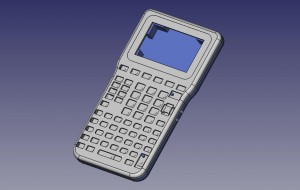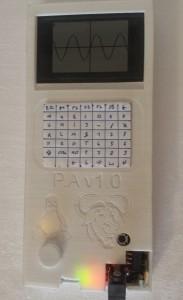I use the calculator function on my smart phone to figure out bill payments or anticipate paycheck amounts, mainly. But there was a time, years ago, when I did use a calculator for math class and standardized exams. It was essential to have one for a period in high school, and for my friends who pursued mathematics in college, they could be counted on to be carrying one in their backpacks. What use would a calculator with a 3D printed case and free, open source software have in the era of the smart phone? That’s a good question to ask since the LibreCalc is a new open source, programmable calculator with a downloadable design available now.
The LibreCalc is really an “embedded computer”, and calculators are frequently the gateway to code and programming –thus proving the inherent educational value of such a device. But I am sure you can start imagining other reasons to have a computer instead of a mere calculator. Yes, that’s tight: during test time. And yes again, that would be called cheating–but who’s keeping track? The LibreCalc exists and anyone who continues to be fascinated by the various frontiers traversed by modern technological innovation will appreciate the device for what it’s worth (especially if that includes a higher score on an important exam!)
The motivation behind this idea is described on the LibreCalc site:
“We aim to make a scientific calculator, fully usable, with good ergonomics, which will be fully free software and open hardware. This calculator will need to have all the capacities of calculators that are currently on the market. In particular it will have to include [a] computer algebra system. Calculators are sometimes the first tool[s] young people use to learn programming. We don’t want that their curiosity [to] be discouraged because manufacturers close their products.”
 This calculator is the brainchild of two young Frenchmen — Pierre Parent and Ael Gain — who explain that they want to bring a computer algebra system (CAS) in a much lower range of prices to classrooms. They even include a section geared toward educators and classrooms on their website, asking for teacher feedback regarding what current calculators are missing. They are determined to make the LibreCalc as accessible as possible–having released all of the hardware designs so that anyone can build this calculator. The LibreCalc is based on the user-friendly and accessible imx233 processor, and all of its designs are available — including the circuit board and CAD files for the case. The calculator’s software is free and it runs Linux. For anyone who has grown used to using Texas Instruments calculators, you can also access a simulator environment to ease your transition to this new calculator.
This calculator is the brainchild of two young Frenchmen — Pierre Parent and Ael Gain — who explain that they want to bring a computer algebra system (CAS) in a much lower range of prices to classrooms. They even include a section geared toward educators and classrooms on their website, asking for teacher feedback regarding what current calculators are missing. They are determined to make the LibreCalc as accessible as possible–having released all of the hardware designs so that anyone can build this calculator. The LibreCalc is based on the user-friendly and accessible imx233 processor, and all of its designs are available — including the circuit board and CAD files for the case. The calculator’s software is free and it runs Linux. For anyone who has grown used to using Texas Instruments calculators, you can also access a simulator environment to ease your transition to this new calculator.
The project is still in its prototype phase, and Parent and Gain have blogged their progress, beginning last February, 2014, with the most recent entry about their second prototype completion entered on December 5, 2014. The recent prototype boasts features including: nicer 3D printed casing and keyboard; 128 MB of Ram; “complete autonomy” (no external cable, computer, or power supply needed for booting–with boot to calculation interface time currently under 8 seconds); and software improvements (including Menu, Python, and Computer Algebra).
Regarding the 3D printed case portion of the project, the blog features a brief entry about the  second case modeling, describing how Blender would be the obvious choice to fulfill their desire to use FreeCAD, but its animation, light, and textures are not proving so useful. On July 15, 2014 a blog entry describes that the design for the first case was done in FreeCAD and 3D printed. A comparison of the first prototype (see in photo to right) and the second prototype (see top photo) shows that the case design has changed quite a bit since the beginning of the project. The layout for the keyboard is completely different.
second case modeling, describing how Blender would be the obvious choice to fulfill their desire to use FreeCAD, but its animation, light, and textures are not proving so useful. On July 15, 2014 a blog entry describes that the design for the first case was done in FreeCAD and 3D printed. A comparison of the first prototype (see in photo to right) and the second prototype (see top photo) shows that the case design has changed quite a bit since the beginning of the project. The layout for the keyboard is completely different.
You can go ahead and see what is available now for downloading here, as the LibreCalc design continues to become refined while responding to user input in a openly public design process. (Also see video that shows the LibrCalc’s second prototype running below.)
Subscribe to Our Email Newsletter
Stay up-to-date on all the latest news from the 3D printing industry and receive information and offers from third party vendors.
You May Also Like
Profiling a Construction 3D Printing Pioneer: US Army Corps of Engineers’ Megan Kreiger
The world of construction 3D printing is still so new that the true experts can probably be counted on two hands. Among them is Megan Kreiger, Portfolio Manager of Additive...
US Army Corps of Engineers Taps Lincoln Electric & Eaton for Largest 3D Printed US Civil Works Part
The Soo Locks sit on the US-Canadian border, enabling maritime travel between Lake Superior and Lake Huron, from which ships can reach the rest of the Great Lakes. Crafts carrying...
Construction 3D Printing CEO Reflects on Being Female in Construction
Natalie Wadley, CEO of ChangeMaker3D, could hear the words of her daughter sitting next to her resounding in her head. “Mum, MUM, you’ve won!” Wadley had just won the prestigious...
1Print to Commercialize 3D Printed Coastal Resilience Solutions
1Print, a company that specializes in deploying additive construction (AC) for infrastructure projects, has entered an agreement with the University of Miami (UM) to accelerate commercialization of the SEAHIVE shoreline...































